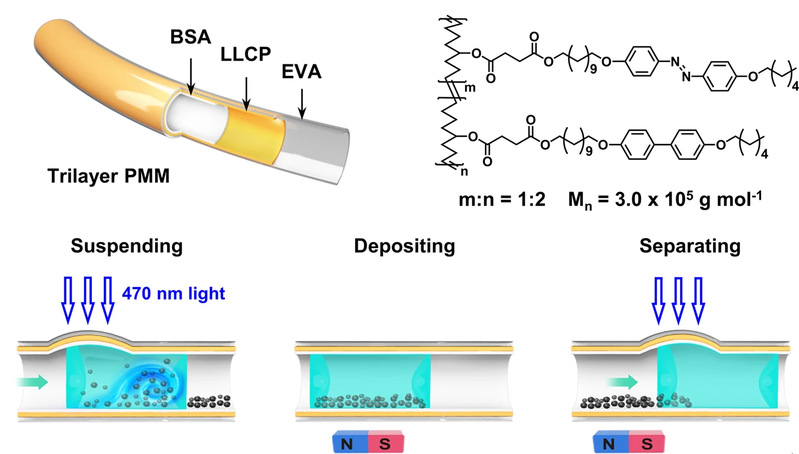Search
Title: Contactless manipulation of mixed phase fluids in liquid crystal polymer microtubes assisted with light-driven vortex
Author: Yao Lu, Lang Qin, Quan Liu, Zichuan Li, Weijia Zhang, Chongyu Zhu*, Yanlei Yu*
Journal: NPG Asia Materials, 2022, 14, 73
Abstract:
Smart channels that manipulate liquid motion by anisotropic shape changes represent a promising candidate to construct microfluidics for biochemical analysis. However, the existing systems fail to provide a platform for solid exchange mediums to interact with multiple liquid phases, which is a universal technique to effectively extract, enrich, and precisely detect biomarkers. Herein, a combined photo/magnetic control strategy of mixed phase fluids, which integrates the contactless operations of suspending, depositing, and even separating, is reported for the first time based on a trilayer microtube consisting of a flexible supporting layer, photodeformable liquid crystal polymer, and hydrophilic blocking layer. The asymmetric photodeformation of the liquid crystal polymer generates an internal vortex in the microtube to homogenously disperse solid exchange mediums into various aqueous moving droplets and to enable efficient purification and enrichment of the target biomarkers. A newly constructed homemade portable protein analyzer guided by the combined photo/magnetic control strategy features the advantages of a short detection time (20 min), trace sample consumption (5 μL), and a low detection limit (1 μg/mL).
Fulltext Link: https://www.nature.com/articles/s41427-022-00424-1#Abs1

In this paper, an optical/magnetic portable protein analyzer was fabricated by using three-layer microtubules containing linear liquid crystal polymer, EVA and hydrophilic coating. The processes of suspending, depositing, and separating for protein extraction and detection was achieved by Laplace pressure and vortex through asymmetric deformation. Such an analyzer specifically purifies, enriches, and detects various proteins in complex samples in a short time (20 min) and with trace sample consumption (5 μL) and a low detection limit (1 μg/mL).







